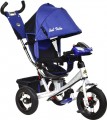Max. weight
The maximum rider weight that the bike can normally carry. This point is directly related to the age group (see above), however, bikes with the same age recommendations may differ in maximum load.
Of course, it is impossible to exceed the load specified by the manufacturer: even if an accident does not happen immediately, it can happen at any time. And ideally, you should choose a bike with a margin of weight — both in case of emergency situations, and taking into account the fact that the child will grow.
Pedal lock
The ability
to “disconnect” the pedals from the wheel so that they do not rotate while the bike is moving. This function is found in three-wheeled models (see “Type”) and is useful when used as a stroller - it eliminates the risk that the baby’s feet will hit the rotating pedals (and this can be fraught with bruises and even injuries).
Backrest tilt adjustment
The ability to tilt the back of the child tricycle allows for a more comfortable position for the child. This solution is primarily justified for models with a parental handle, when the bike is used as a stroller — to transport the baby by the parent. Naturally, during such walks, the child may get tired and want to sleep. And leaning back to take a nap will be more comfortable for him.
Country of origin
The country of origin of the brand under which the product is marketed. Often indicated by the nationality of the company or the location of its headquarters. At the same time, the actual production capacity of the brand often differs from the country of origin.
It should be noted that the quality of products depends not so much on geography, but on the peculiarities of the organization of processes and quality control at all stages of production. Therefore, national prejudices regarding brands from certain regions, as a rule, are not supported by anything. It is necessary to pay attention to the country of origin of the brand only if the task is to fundamentally support or bypass the manufacturer from a particular state.

